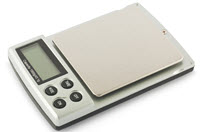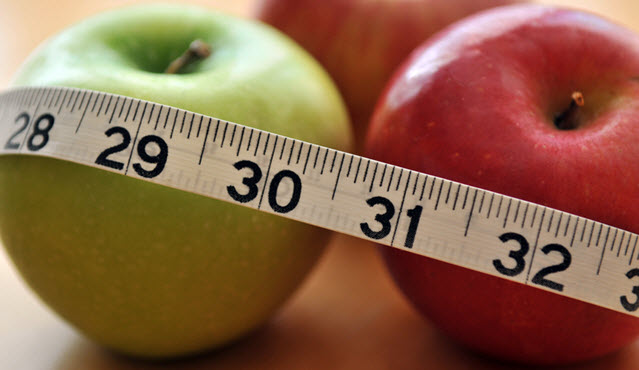It’s no secret that the average weight of people in North America has ballooned over the last 30 years. But why are we seeing such a dramatic increase in average weight? And what can we do to fix the problem?
Average portion sizes of food have increased greatly since the 1980’s. Now we are seeing larger bagels, larger muffins, pasta meals that contain enough calories for a whole day, and coffee drinks that have over 400 calories. We have been “seduced” into thinking that these larger portion sizes are normal. But these large portions are not normal, and we are paying the price in our health.
In order to learn the proper portion sizes for your favourite recipes, a simple kitchen scale can be a huge help in teaching you how much food you should be eating. But before you get started, first determine the number of calories for your height and weight using the Calorie Calculator on this site. Then track your food using a recipe calculator such as the one available at SparkPeople. You might think that this is way too much trouble, but if you can track your food for about one month, you will have learned a lot about the right portions of the foods that you like to eat.
Determining portion sizes
It isn’t always clear how many calories you are eating even when the nutrition label describes the number of calories. For example, I like to eat sliced turkey in my sandwiches. The label says that 3 slices of the turkey is equal to 70 calories. But the slices are from actual turkey breast, and the size of each slice varies a lot. I was never really sure how much turkey I was eating by just looking at the product label.
Kitchen scale to the rescue!
 Most people grossly underestimate the portion size of foods. A fantastic tool to help you to learn about the correct portion sizes is a kitchen scale. I now keep an inexpensive digital kitchen scale on my kitchen counter so that I can easily measure foods when needed.
Most people grossly underestimate the portion size of foods. A fantastic tool to help you to learn about the correct portion sizes is a kitchen scale. I now keep an inexpensive digital kitchen scale on my kitchen counter so that I can easily measure foods when needed.
When I make my own recipes, I am able to enter my recipe into the recipe calculator at SparkPeople. I can calculate the total calories for the recipe. But trying to determine the number of calories per serving has been a guess because I was just estimating the number of servings (I tend to make large pots and casseroles).
The kitchen scale has helped me to know exactly what I am eating. Now I do not need to guess at the calories I am eating. I can weigh the food and then know exactly what I am eating. If you think it is too much trouble to weight your food, think again – it takes only a few seconds to weigh each food item.
Tips
Below are a few tips to help you get the most information from your kitchen scale:
- Keep the kitchen scale within easy reach – preferably on your kitchen counter if you have the space.
- Most kitchen scales allow you to subtract a bowl or plate so that you can measure the food without having to subtract the weight of the plate or bowl. But you should also know the weights of larger containers such as pots and casseroles, since it is not easy to subtract the weight of the container when it is already full of food! I recommend that you weigh your pots and casserole dishes and keep this list in your kitchen so that you can subtract these when you make your favorite recipe.
- Keep a pen and notepad on your kitchen counter so that you can list the ingredients of your recipes. Then you can calculate the caloric content using a nutrition calculator such as the one at SparkPeople when you have the time so enter it into the recipe database.
- To figure out the calories per serving in your recipe for a soup, casserole, or main dish, enter the ingredients into the Recipe Calculator. Weigh your total dish to know the total weight. Then weigh your portion – this will tell you the portion size. In the Recipe calculator, you enter the number of servings for the dish, and the Recipe calculator tells you the nutritional breakdown per serving.
- You might find it useful to check the weights of foods that you commonly eat. Usually the nutritional breakdown on the label is pretty accurate, but it can som etimes be incorrect. Recently, I checked the weight of back bacon. The label stated that the bacon was 20 gm per slice, but the actual weight was 40 gm!
I highly recommend that you use a kitchen scale to help you to understand exactly what you are eating. An inexpensive kitchen scale can greatly increase your chances of success in following a diet that is healthy and that includes portions that are the correct size for your body.

